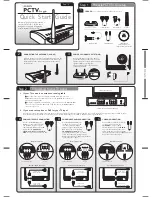
18
1.
Using a partner, lift the TV and use the upper hooked side of
the bracket to lock onto the lip of the wall mount.
See Photo #32.
Before lowering the TV down, make sure that your wires are
ready for connection. If your TV will not allow connections to be
made when it is flat against the wall, take this time to connect
them while your partner holds the TV in place.
3.
Once all the
wires are connected or ready to be connected, gently place the
TV flat against the wall, taking care that no wires get caught or
pinched.
4.
Take this time to double check that the TV is level.
Once this is verified, secure all locking screws or bars.
If you've made it to this point, congratulations on a job well done!
(
Note:
This information is provided to help guide your installation. Haier assumes no liability for errors
or the outcome of any installation since each project is unique and tools, materials, techniques, local
codes and regulations vary and change.)Preparing for Your Installation In planning your speaker
installation, there are some questions you'll need to ask yourself first. Once these are answered, you're
ready to begin your project:
Seating area
Is the system designed around a "sweet spot" or for the same sound everywhere? There are
different products for different designs.
What kind of seating do you want? Is the room primarily a home theater entertainment area, or will
music be part of what it's used for as well?
Aesthetics
What speaker sizes are you planning to use? Make sure the ones you choose don't overwhelm the
room.
Wire access
Have you planned how you will run wires to your speaker locations?
Speaker Breakdown - See our Speaker Selection »
Floor standing/Tower Speakers
These are the
largest speakers and the most common in dedicated home theater rooms. They consist of a larger
cabinet for the components and have different sized drivers inside. Some towers even come with
amplifiers built into the cabinet. This construction usually allows for the best sound, but they can be
imposing from a price and appearance standpoint.
Bookshelf Speakers
Quite a bit smaller than their
floor standing cousins, these speakers are designed to provide a happy medium between sound quality
and space efficiency. While bookshelf speakers will lose some of the performance of a larger speaker,
their size makes them a popular choice for many rooms.
Satellite Speakers
In areas where space is at
a premium, satellite speakers are a popular choice. These are small, usually plastic, and are often
included in many cost-effective "home theater in a box" packages. Their small size and cost
effectiveness make them an ideal choice for smaller rooms or a budget system, but their sound quality
often comes up short when compared to higher quality options.
Recessed Speakers
Some companies
offer a type of speaker that uses the wall or the ceiling as an enclosure. In other words, these
"recessed" speakers put the empty space in those areas to work for you. You will need to consider a
Summary of Contents for HL15E-D
Page 29: ...29 ...
Page 51: ...40 11 WIRING CONNECTION DIAGRAM ...
Page 57: ...46 Sincere Forever ...
















































